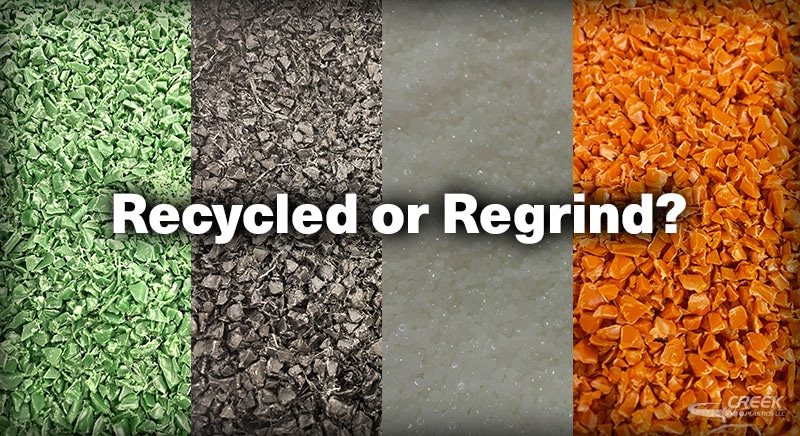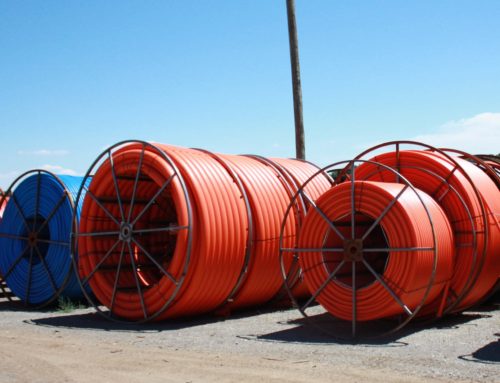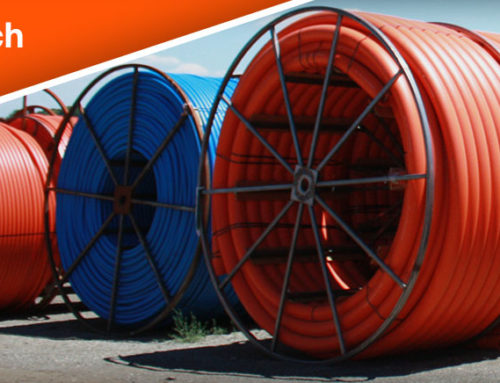Creek Plastics does not use recycled plastic materials in any of its products. Recycled material is the process of recovering scrap or waste plastic and reprocessing the material into useful products. Recycled materials are not intended for long-term service and do not meet the industry ASTM standard specifications. Creek Plastics piping products are manufactured in accordance with industry standards for protecting fiber and cable applications.
Industry standards allow the use of regrind material in HDPE piping products. Regrind (reworked) is virgin resin that has been processed and scrapped because it did not meet industry specifications. Regrind materials never leave the manufacturing plant location. This material is reprocessed in-plant and used in the manufacturing of new pipe. With the unknown conditions of the material, Creek Plastics does not accept any returned materials. This could affect the product’s integrity.
Regrind is used in combination with virgin resin anywhere from a 10-40% ratio. The combination virgin/regrind pipe is tested to make sure the properties meet the specifications. ASTM, UL, and NEMA all allow the use of regrind resin in their specifications.
A two-foot sample is taken from every reel made at Creek Plastics and is kept for two years. Creek Plastics quality lab measures each sample product for OD (outside diameter), wall thickness, and ovality before being distributed.
Creek Plastics conduit is made from high-density polyethylene (HDPE). The HDPE meets or exceeds the properties listed in ASTM D-3350 for minimum cell classification of 335480 C (black minimum 2% carbon black) or E (color with UV stabilizer). Properties are listed in the chart below.
| PROPERTIES OF POLYETHYLENE RESIN | ||
| ASTM TEST | PHYSICAL PROPERTY | TYPICAL VALUE |
| D-1505 | Density g/cm3 | 0.941 – 0.955 |
| D-1238 | Melt Index, g/10 min Con 190/ 2.16 | .15 – .4 |
| D-638 | Tensile Strength at Yield (psi) | 3000 – <4000 |
| D-1693 | ESCR Condition B F20 | > 192 hours |
| D-790 | Flexural Modulus, Mpa (psi) | 80,000 – <160,000 |
HOW ITS MADE
RAW MATERIAL
The raw material is supplied to the pipe producer in non-pigmented pellets. The raw material is shipped in 180,000–200,000-pound capacity railcars, 40,000-pound bulk trucks or 1,000–1,400-pound boxes.
Pipe producers must conduct quality control procedures to test against specification requirements such as melt index, density, flexural modulus, tensile strength, moisture content and contamination. Once incoming resin passes quality testing, the resin is then transferred from the bulk transporters to the silos at the plant site. From there the resin is transferred to the pipe extruder by a vacuum transfer system.
PIPE EXTRUSION LINE
Pipes are produced by extruding molten polymer through a die opening into sizing and cooling devices that stabilize the final dimensions. The pipe extrusion line generally consists of the extruder, die, cooling systems, puller, and take-off equipment. The essential steps of the production of HDPE pipe are to heat, melt, mix and convey the polymer into a particular shape and hold that shape during the cooling process.
EXTRUDER
The extruder heats, melts, mixes, and conveys the polymer to the die, where it is shaped into a pipe. The extruder screw design is critical to the performance of the extruder and the quality of the pipe. The rotation of the screw conveys the plastic forward through the heated barrel. As the plastic is conveyed forward along the screw the channel depth decreases forcing the plastic through a smaller area. The combination of compression and screw rotation causes friction which generates heat. This is called shear heating. This heat along with the heat from the barrel heating system melts the plastic.
By the time the plastic is conveyed by the end of the screw, it should be well mixed and at a proper temperature and pressure needed by the die. The plastic is called a melt at this stage.
DIE DESIGN
In the plastic extrusion process, extrusion dies are used to impart geometrical shapes to the selected polymer. The die supports and distributes the homogeneous polymer melt around the solid mandrel, which forms it into an annual shape for solid wall pipe. There are two common types of die designs for solid walls; the spider die design and the basket die design. Both designs refer to the manner in which the melt is broken and distributed into an annual shape and also the means by which the mandrel is supported.
PIPE SIZING
The sizing and cooling operations determine the dimensions and tolerances of the pipe. The sizing holds the pipe in its proper dimensions during the cooling of the molten material. To produce a solid wall pipe, the hot material is drawn from the die through a sizing sleeve and into a cooling tank. The sizing may be accomplished by using either vacuum or pressure techniques.
COOLING
For the pipe to maintain its circularity, the pipe must be cool enough before it exits the cooling tank. There are various methods of cooling that are utilized to remove the residual heat out of the pipe. Smaller diameter pipe is usually immersed in a water bath with a temperature range of 40°F to 50°F.
PULLERS
During the entire cooling operation, the puller must provide the necessary force to pull the pipe. By providing a constant pull rate, it allows the pipe to maintain the proper wall thickness. The wall thickness of the finished pipe is determined by the rate at which the pipe is pulled, in combination with the extruder screw speed. Increasing the puller speed at a constant screw speed reduces the wall thickness while reducing the puller speed at the same screw speed increased the wall thickness.
At the end of the extrusion line, the standards of ASTM and other specifications are marked at frequent intervals. The markings consist of nominal pipe size, type of plastic, SDR/SCH, manufacturers name, and date. Marking techniques include hot stamp, inkjet, and indent printing.
TAKE-OFF EQUIPMENT
Pipe four inches or smaller can be coiled for handling and shipping convenience. The take-off equipment allows the pipe to be coiled in various lengths. Depending upon the pipe size, lengths of up to 10,000 feet can be coiled.
Stick pipe is cut into specific lengths, typical lengths are 20 and 40 feet, for storage and shipping. The pipe is bundled before it is placed on the truck or railcar. Bundling of the pipe provides ease of handling and safety during loading and unloading.
*** Some research was obtained from the Plastic Pipe Institute





